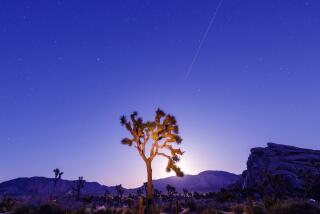Moon’s magnetic material may have come from an asteroid
A giant crater at the moon’s south pole may hold the answer to a long-standing mystery about why portions of the lunar crust have a magnetic field and other parts don’t.
After running sophisticated computer models, a trio of researchers is suggesting that mysterious magnetic material detected on the surface was delivered by a 120-mile-wide asteroid that crashed into the moon about 4.5 billion years ago. The collision left behind a gaping hole on the far side of the moon that is one of the largest-known impact craters in the solar system.
The South Pole-Aitken basin is “this huge, whopping crater that’s roughly half the size of the U.S.,” said Mark Wieczorek, lead author of a paper about the discovery published in Friday’s edition of the journal Science. The presence of magnetized patches near its northern rim led Wieczorek and his colleagues to think there might be a connection.
The moon doesn’t have a global magnetic field as the Earth does, but things may have been different in the distant past.
Scientists have detected local magnetic fields in moon rocks and from measurements taken from space, and that leads them to believe that some moonwide field most likely existed at some point. The field could have been generated by energy from asteroid impacts or a dynamo in the moon’s metallic core that long ago petered out.
Lunar magnetism has no direct impact on the Earth. But scientists are interested in it because it offers a window into the moon’s early history — and, since the moon is thought to have broken off from a young Earth, ours as well, said William Bottke, director of the Center for Lunar Origin and Evolution at the Southwest Research Institute in Boulder, Colo., who wasn’t involved in the study.
Researchers have wondered about the moon’s regions of strongly magnetized rock ever since the Apollo 12 crew discovered them in 1969, said Wieczorek, a planetary scientist at the Paris Institute for Global Physics.
The magnetic anomalies didn’t seem to correlate with any geologic structures that might hold clues about their origins — features such as craters, volcanoes or lava flows. Typical moon rocks have a low iron content, which means that they don’t have great potential to become magnetized in the first place.
Throw in the moon’s present lack of a magnetic field, some sort of which would have been needed to magnetize the rocks, and planetary scientists were stumped.
But as spacecraft gathered more data on the South Pole-Aitken basin, Wieczorek and colleagues Benjamin Weiss and Sarah Stewart, both of Harvard University, began to think that the 1,200-mile-wide basin might be involved.
The formation is slightly elliptical in shape, suggesting that it was created by an oblique impact from a very large object. The most likely candidate would be an asteroid, which can be 10% to 30% metallic iron by weight and about 100 times more magnetic than typical lunar materials, Wieczorek said.
A powerful, angled hit would have sprayed iron material downrange from the impact — corresponding, potentially, to where strong magnetic anomalies had been mapped.
If the moon did have a magnetic field at the time of the impact 4.5 billion years ago — a distinct possibility, Wieczorek said — then the metallic debris could have been magnetized as it cooled, leading to the puzzling arrangement of magnetic regions that exists today.
The team tested the theory by running computer simulations of impacts. Varying a number of parameters, including the velocity and impact angle of the asteroid as well as its composition and size, they determined that the scenario that best fit the observations was an asteroid hitting the moon at a 45-degree angle while traveling about 9 miles per second.
Such an impact would have been normal, Wieczorek said. “We don’t require improbable conditions.”
Others who study the moon said that the team’s hypothesis would help researchers get to the bottom of the lunar magnetism mystery.
“I think it’s a good idea. I’m surprised no one really explored it earlier,” said Ian Garrick-Bethell, a professor of planetary science at UC Santa Cruz.
But some weren’t convinced that Wieczorek and his colleagues were on the right track.
Lon Hood, a senior research scientist at the Lunar and Planetary Laboratory at the University of Arizona in Tucson, believes that the anomalies were created by more recent impacts on a different part of the moon, which he said correlate more cleanly with evidence from the lunar surface.
“I wish the moon was simpler than it is,” he said.
Wieczorek said the next big problem to solve is how and when a magnetic field developed on the moon.
Ultimately, the best way to get to the bottom of it all, he added, would be to go back to the moon and collect samples.







